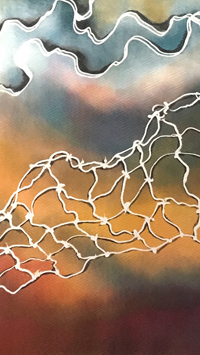
 |
We Mend Our Nets So Our Children’s Children May Fish
Indigo, cochineal, and ocher pigments, soy sizing, rice paste resist,
on kimono silk, juniper hanger.
Cochineal, made of the dried insect Dactylopius coccus, was the great treasure of the western hemisphere, worth its weight in gold to early traders. It is still raised today and valued as a natural dye both for fabrics and food. Renaissance painters conseidered it “the perfect red.”
73”T x 25”W
$400
Nets:
One evening winter evening I came in exhausted, ready to crash. As I fell asleep a vision began to form in my mind—
I am an old woman,
sitting by the shore,
mending nets for those who will take them to sea,
to gather a harvest in some future I can only imagine.
The next morning I began to sketch these images: sand, nets, waves, the cosmic “beyond.” As I worked I thought more about nets: we make them for gathering, for ensnaring, for connecting. We speak of “safety nets,” the world wide net, the net of creation. We sleep in hammocks, use nets in many of our games.
Humans fashion nets from string, cordage first twisted millennia ago—did we get the idea from nature?
From an orb weaver,
who sits in the shadows on her web,
waiting to scramble at the first ping?
From the tangle of marsh grass,
or perhaps from the woven nests of birds?
And there is the Celtic knot which symbolizes eternity.
According to Elizabeth Wayland Barber,* the “string revolution” was a major turning point in our cultural evolution. Once we “invented” string, we could make tools. Nets must have been one of the first.
I imagine nets stretching out across space, across time. There is a net beginning in the ancient past flowing past me into the future. I am but a node where strands intersect…
Creature, plant and mineral are all connected in this wondrous multidimensional web.